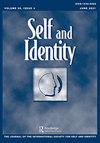穆斯林少数民族青少年的双重身份、双文化身份整合与社会身份复杂性
IF 2.1
4区 心理学
Q3 PSYCHOLOGY, SOCIAL
引用次数: 8
摘要
摘要:我们研究了英国(研究1,n=773,M=17.5岁)和美国(研究2,n=190,MW1=14.1岁)穆斯林青少年的民族和宗教认同、双文化认同整合(BII)和社会认同复杂性(SIC)之间的横截面和纵向关联。采用以人为本的方法,我们确定了四组青少年。在这两个国家背景下,最大的两个群体是“以宗教为导向的强大双重标识符”和“同样强大的双重标识符”。后者经历了更少的BII距离和更多的BII冲突,并认为他们的身份更加相似和重叠。这些发现强调,强烈的双重身份模式和轨迹的细微差异对强烈的双重认同的体验和感知方式有影响。本文章由计算机程序翻译,如有差异,请以英文原文为准。
Dual identity, bicultural identity integration and social identity complexity among Muslim minority adolescents
ABSTRACT We examined cross-sectional and longitudinal associations between national and religious identification, Bicultural Identity Integration (BII), and Social Identity Complexity (SIC) among Muslim adolescents in the UK (Study 1, n = 773, M = 17.5 years) and the U.S. (Study 2, n = 190, MW1 = 14.1 years). Using person-oriented approaches, we identified four groups of adolescents. The two largest groups in both national contexts were “religiously-oriented strong dual identifiers” and “equally-strong dual identifiers”. The latter experienced less BII distance and more BII conflict, and perceived their identities as more similar and overlapping. These findings highlight that nuanced differences in strong dual identity patterns and trajectories have implications for how strong dual identities are experienced and perceived.
求助全文
通过发布文献求助,成功后即可免费获取论文全文。
去求助
来源期刊

Self and Identity
PSYCHOLOGY, SOCIAL-
CiteScore
5.10
自引率
5.00%
发文量
26
期刊介绍:
Work on self and identity has a special place in the study of human nature, as self-concerns are arguably at the center of individuals" striving for well-being and for making sense of one"s life. Life goals develop and are influenced by one"s view of what one is like, the way one would ideally like to be (or would like to avoid being), as well as one"s perceptions of what is feasible. Furthermore, conceptions of self and the world affect how one"s progress towards these goals is monitored, evaluated, redirected, re-evaluated, and pursued again. Thus, the “self” as a construct has far-reaching implications for behavior, self-esteem, motivation, experience of emotions and the world more broadly, and hence for interpersonal relationships, society, and culture.
 求助内容:
求助内容: 应助结果提醒方式:
应助结果提醒方式:


